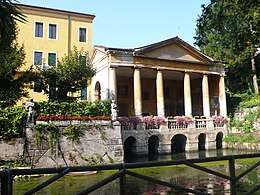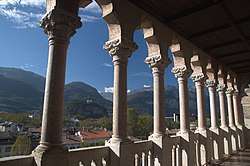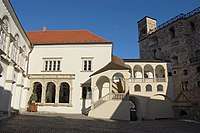Loggia
A loggia (/ˈloʊdʒ(i)ə/ LOH-j(ee-)ə, usually UK: /ˈlɒdʒ(i)ə/ LOJ-(ee-)ə, Italian: [ˈlɔddʒa]) is an architectural feature which is a covered exterior gallery or corridor usually on an upper level, or sometimes ground level. The outer wall is open to the elements, usually supported by a series of columns or arches. Loggias can be located either on the front or side of a building and are not meant for entrance but as an out-of-door sitting room.[1][2][3] An overhanged loggia may be supported by a baldresca.[4]


From the early Middle Ages, nearly every Italian comune had an open arched loggia in its main square, which served as a "symbol of communal justice and government and as a stage for civic ceremony".[5]
Definition of the Roman loggia

The main difference between a loggia and a portico is the role within the functional layout of the building. The portico allows entrance to the inside from the exterior and can be found on vernacular and small scale buildings. The loggia is accessed only from inside and intended as a place for leisure. Thus, it is found mainly on noble residences and public buildings. A classic use of both is that represented in the mosaics of Basilica of Sant' Apollinare Nuovo of the Royal Palace.
Loggias differ from verandas in that they are more architectural and, in form, are part of the main edifice in which they are located, while verandas are roofed structures attached on the outside of the main building.[1][6] A "double loggia" occurs when a loggia is located on an upper floor level above a loggia on the floor beneath.
Examples
- In Italian architecture, a loggia often takes the form of a small, often ornate, summer house built on the roof of a residence to enjoy cooling winds and the view. They were especially popular in the 17th century and are prominent in Rome and Bologna, Italy.
- Grinnell College in Grinnell, Iowa, contains three distinct sets of dorms connected by loggias. The main quad on the Stanford University campus in Stanford, California, prominently features loggias, as do the University Center and Purnell Center for the Arts at Carnegie Mellon University, which frame a quad known as the Cut.
- In the city centre of Chester in England, a number of timber-framed buildings dating from the medieval to Victorian periods have first-floor loggias called the Chester Rows.
- In Russia and Switzerland, a loggia can be a form of recessed balcony on a residential apartment building.
- A loggia was added to the Sydney Opera House in 2006.
- At the archeological site of Hagia Triada on the Greek island of Crete, several loggias constructed around 1400 BC have been located and whose column bases still remain.[7]
 The Venetian Gothic loggia of the Buonconsiglio Castle in Trento, Italy
The Venetian Gothic loggia of the Buonconsiglio Castle in Trento, Italy- The loggia of the Edificio La Inmobiliaria in Buenos Aires, Argentina
- A mosaic found in the chapel of the 6th-century Basilica of Sant'Apollinare Nuovo in Ravenna, Italy depicts a loggia.
- Loggia shape serliana, Palazzo di Brera in Milan, Italy
 The 17th century Renaissance Lorántffy loggia in the Castle of Sárospatak, Borsod-Abaúj-Zemplén County, Hungary
The 17th century Renaissance Lorántffy loggia in the Castle of Sárospatak, Borsod-Abaúj-Zemplén County, Hungary
Notes
- "Definition of Loggia". Lexic.us. Retrieved on 2014-10-24.
- "Loggia". The Free Dictionary. Retrieved on 2014-10-24.
- "loggia". Merriam-Webster Disctionary Online. Retrieved on 2014-10-24.
- Alamán, Ana Pano (2020). The Language of Art and Cultural Heritage: A Plurilingual and Digital Perspective. Cambridge Scholars Publishing. p. 27. ISBN 978-1-5275-4798-8. Retrieved 3 August 2020.
- Ackerman, James S. (1966). Palladio. Harmondsworth: Penguin. p. 120.
- "Veranda". Merriam-Webster Disctionary Online. Retrieved on 2014-10-24.
- Vasilakis, Antonis. Phaistos. Vasilis Kouvidis - Vasilis Manouras Editions, Iraklio, p. 118 ISBN 960-86623-6-2
References
- Curl, James Stevens (2006). A Dictionary of Architecture and Landscape Architecture (paperback) (Second ed.). Oxford University Press. p. 880. ISBN 0-19-860678-8.